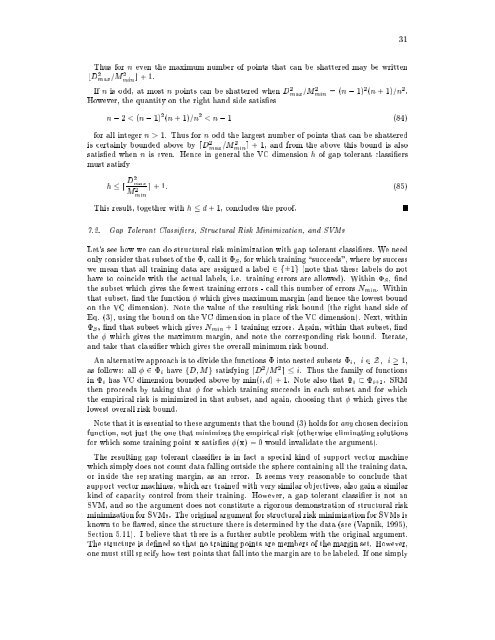A Tutorial on Support Vector Machines for Pattern Recognition
A Tutorial on Support Vector Machines for Pattern Recognition
A Tutorial on Support Vector Machines for Pattern Recognition
Create successful ePaper yourself
Turn your PDF publications into a flip-book with our unique Google optimized e-Paper software.
31Thus <strong>for</strong> n even the maximum number of points that can be shattered may bewrittenbD 2 max=M 2 min c +1.If n is odd, at most n points can be shattered when D 2 max =M 2 min =(n ; 1)2 (n +1)=n 2 .However, the quantity <strong>on</strong>theright hand side satisesn ; 2 < (n ; 1) 2 (n +1)=n 2 1. Thus <strong>for</strong> n odd the largest number of points that can be shatteredis certainly bounded above by dDmax=M 2 min 2 e +1, and from the above thisbound is alsosatised when n is even. Hence in general the VC dimensi<strong>on</strong> h of gap tolerant classiersmust satisfyh d D2 maxe +1: (85)Mmin2This result, together with h d + 1, c<strong>on</strong>cludes the proof.7.2. Gap Tolerant Classiers, Structural Risk Minimizati<strong>on</strong>, and SVMsLet's see how we can do structural risk minimizati<strong>on</strong> with gap tolerant classiers. We need<strong>on</strong>ly c<strong>on</strong>sider that subset of the , call it S , <strong>for</strong> which training \succeeds", where by successwe mean that all training data are assigned a label 2f1g (note that these labels do nothave to coincide with the actual labels, i.e. training errors are allowed). Within S , ndthe subset which gives the fewest training errors - call this number of errors N min . Withinthat subset, nd the functi<strong>on</strong> which gives maximum margin (and hence the lowest bound<strong>on</strong> the VC dimensi<strong>on</strong>). Note the value of the resulting risk bound (the right hand side ofEq. (3), using the bound <strong>on</strong> the VC dimensi<strong>on</strong> in place of the VC dimensi<strong>on</strong>). Next, within S , nd that subset which gives N min + 1 training errors. Again, within that subset, ndthe which gives the maximum margin, and note the corresp<strong>on</strong>ding risk bound. Iterate,and take that classier which gives the overall minimum risk bound.An alternativeapproach is to divide the functi<strong>on</strong>s into nested subsets i i 2Z i 1,as follows: all 2 i have fD Mg satisfying dD 2 =M 2 ei. Thus the family of functi<strong>on</strong>sin i has VC dimensi<strong>on</strong> bounded above bymin(i d)+1. Note also that i i+1 . SRMthen proceeds by taking that <strong>for</strong> which training succeeds in each subset and <strong>for</strong> whichthe empirical risk is minimized in that subset, and again, choosing that which gives thelowest overall risk bound.Note that it is essential to these arguments that the bound (3) holds <strong>for</strong> any chosen decisi<strong>on</strong>functi<strong>on</strong>, not just the <strong>on</strong>e that minimizes the empirical risk (otherwise eliminating soluti<strong>on</strong>s<strong>for</strong> which some training point x satises (x) =0would invalidate the argument).The resulting gap tolerant classier is in fact a special kind of support vector machinewhich simply does not count data falling outside the sphere c<strong>on</strong>taining all the training data,or inside the separating margin, as an error. It seems very reas<strong>on</strong>able to c<strong>on</strong>clude thatsupport vector machines, which are trained with very similar objectives, also gain a similarkind of capacity c<strong>on</strong>trol from their training. However, a gap tolerant classier is not anSVM, and so the argument does not c<strong>on</strong>stitute a rigorous dem<strong>on</strong>strati<strong>on</strong> of structural riskminimizati<strong>on</strong> <strong>for</strong> SVMs. The original argument <strong>for</strong> structural risk minimizati<strong>on</strong> <strong>for</strong> SVMs isknown to be awed, since the structure there is determined by the data (see (Vapnik, 1995),Secti<strong>on</strong> 5.11). I believe that there is a further subtle problem with the original argument.The structure is dened so that no training points are members of the margin set. However,<strong>on</strong>e must still specify howtestpoints that fall into the margin are to be labeled. If <strong>on</strong>e simply


